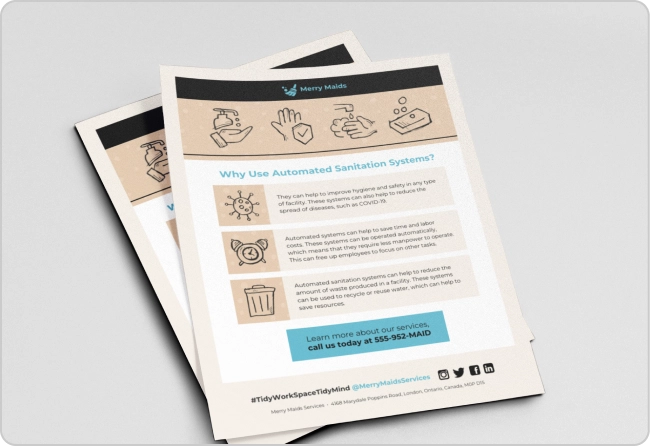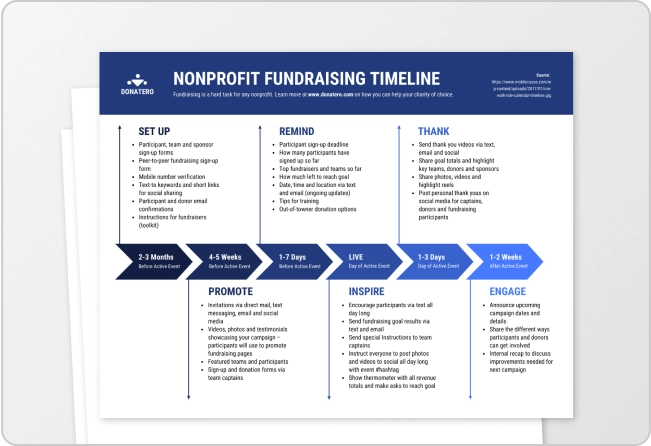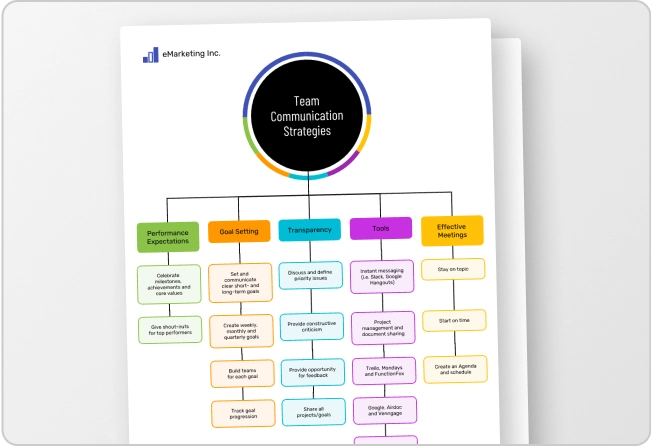
An action plan is a meticulously structured strategy that pinpoints specific steps, tasks and resources vital to turning a goal into reality. It is extremely useful in any project management.
Crafting an action plan is like plotting a route for a cross-country journey. It’s the strategic map that outlines every step, decision and pitstop needed to reach your ultimate destination.
With a well-thought-out action plan, you’re not just shooting in the dark; you’re making informed, purposeful strides towards your goals. Dive deep with our guide and witness real-world examples that will inspire and guide you.
Need a tool to kickstart your planning? Try out the Venngage business plan maker and explore their extensive collection of action plan templates.
How to write an action plan step-by-step
Creating an effective action plan is a foundational step toward turning aspirations into tangible results. It provides a clear roadmap, ensuring that each step taken aligns with your overall objective.
And here’s something important to keep in mind: an action plan isn’t just a rough set of ideas in your head. It’s typically created as a formal document, something you can write up in a Word doc, Google Doc, PDF or even a spreadsheet.
These documents can be printed and used in meetings, trainings, or collaborative planning sessions. They’re often shared with teammates, managers, or clients to keep everyone aligned and accountable.
Action plans are often created as printable or digital documents. You can use ready-made templates to quickly turn your plan into a shareable, professional document.
Whether you’re aiming to enhance a business process or achieve a personal goal, a well-drafted action plan can be your guiding light. Here are the key steps to help you create one:
- Step 1: Establish SMART goals: Start by setting SMART goals—Specific, Measurable, Achievable, Relevant and Time-bound. These clearly defined objectives act as the foundation for your entire action plan. When your goals are focused and realistic, it becomes much easier to break them into actionable steps and track progress. Clarity here sets the tone for everything that follows and it’s what often separates success from stalled plans.
- Step 2: Determine necessary tasks: Decompose your action plan goal into smaller, action items or tasks. This modular approach not only makes the mission less daunting but also provides a sequential pathway to goal attainment.
- Step 3: Assign essential resources: Depending on the tasks at hand, designate necessary resources, be they human, financial or technological. This ensures that every activity has the backing it needs for successful execution.
- Step 4: Prioritize tasks by importance: Not all tasks hold equal weight. Determine the hierarchy of tasks based on their impact on the goal and their time sensitivity. This allows for a systematic progression.
- Step 5: Outline timelines and key markers: With tasks in hand, set clear deadlines for each. Introduce milestones, which act as periodic check-ins, ensuring you’re on track and allowing for celebrations of smaller victories.
- Step 6: Oversee and modify your strategy blueprint: As you progress, there will invariably be learnings and challenges. Regularly review your plan to make necessary adjustments, ensuring its relevance and effectiveness.
- Step 7: Consider ready-to-use templates: If starting from scratch feels overwhelming, lean on structured templates to guide your planning. There’s plenty of business plan softwares and platforms such as Venngage that offer a plethora of action plan templates, tailored to various needs, which can significantly streamline the process.
15 Action plan examples
Action plans serve as blueprints, guiding the steps and resources needed to achieve a specific goal.
They come in various formats, tailored to different scenarios and objectives. Here, we present a range of action plan examples that cater to diverse purposes and situations.
From business strategies to simple task lists, these examples illustrate the versatility and importance of well-structured planning.
Business action plan examples
A business action plan is essentially a strategy roadmap, meticulously tailored for realizing broader business objectives. By crafting a solid action plan, businesses can channel their resources, manpower and strategies in a direction that harmonizes with their larger vision.
Key to this plan is the identification and alignment of steps that resonate with the company’s comprehensive strategy, ambitions of growth and aspirations for operational enhancements. Increasingly, organizations are turning to business agility through application modernization as a practical lever to accelerate results and maintain a competitive edge.
While this might entail a myriad of specific steps based on unique business goals, some common elements include setting clear key performance indicators (KPIs), undertaking a thorough SWOT (Strengths, Weaknesses, Opportunities, Threats) analysis to grasp the current business landscape and establishing a timeline to keep track of progress.
Furthermore, allocating responsibilities to team members or individuals ensures that every aspect of the strategy has a dedicated focus. Budgeting, essential to the success of the action plan, ensures that every initiative is financially viable and sustainable.
Regular reviews and iterations based on feedback and changing market dynamics keep the action plan agile and relevant.
Related: 5 Steps to Create an Actionable Employee Development Plan [with Templates & Examples]
Company action plan examples
A comprehensive company action plan serves as the strategic linchpin, ensuring a coherent and coordinated approach to realizing organizational goals. Central to this plan is the incorporation of rigorous market research and analysis, which provides insights into consumer behaviors, market trends and potential opportunities.
Equally vital is the focus on product development and procurement, ensuring that the offerings align with market demands and stand out in terms of quality and relevance.
Alongside, adept legal and financial management safeguards the company’s interests, ensuring compliance with regulations and prudent fiscal oversight.
Moreover, the essence of any successful company action plan lies in its sales and marketing strategies. These define how the products or services are positioned and promoted in the market, ensuring visibility and engagement with the target audience.
However, while acquisition is crucial, retention plays an equally significant role. Hence, impeccable customer service and nurturing relationships become indispensable components, fostering loyalty and ensuring that clients remain ambassadors for the brand long after the initial transaction.
Related: 30+ Project Plan Examples to Visualize Your Strategy (2023)
Sales action plan examples
A well-structured sales action plan serves as the backbone for systematic and efficient progress. Central to this plan is the identification and utilization of the most effective sales channels, whether they are direct, online or through third-party avenues.
Clarity on the products and services on offer, combined with their unique selling propositions, facilitates tailored and resonant sales pitches.
Budget considerations ensure that resources are judiciously allocated, balancing the act between expenditures and potential returns. This financial prudence is complemented by setting realistic sales projections, which act as both a motivational target and a yardstick for success.
Timelines, or proposed deadlines, infuse the process with a sense of urgency, ensuring that the momentum of the sales drive is maintained.

However, the true measure of the action plan’s efficacy lies in its key performance indicators (KPIs). These metrics, be it lead conversion rates or customer retention figures, serve as tangible markers, highlighting the plan’s strengths and signaling areas that might require recalibration to increase sales.
Corrective action plan examples
The essence of a corrective action plan lies in its meticulous structure, tailored to address and rectify deviations or inefficiencies identified within an organization. At its core, each action item serves as a focal point, detailing specific areas or processes that require intervention.
Accompanying each action item is a clear description that provides a comprehensive understanding of the issue at hand.
However, merely identifying a problem isn’t enough; delving deep into its origins through root cause analysis ensures that solutions target the fundamental issues, rather than just addressing superficial symptoms.
This analysis then paves the way for defining the corrective action, a tangible step or series of steps designed to mitigate the identified problem and prevent its recurrence.
Besides, to ensure the plan’s effectiveness, assigning a responsible person to each action item is paramount. This individual or team is entrusted with the task’s execution, ensuring accountability and focus.

The status of each action keeps stakeholders informed about the progress, be it in the planning phase, ongoing, or completed.
Lastly, setting a due date for each corrective action introduces a sense of urgency and purpose, ensuring that issues are addressed in a timely manner, minimizing disruptions and maximizing operational efficiency.
Action plan for employee performance improvement
When an employee isn’t meeting expectations, a performance improvement plan can be a turning point—if it’s structured and supportive. Instead of vague feedback or occasional reminders, a clear action plan outlines what needs to improve, how to get there, and what success looks like.
For example, if a team member has been struggling with accuracy in reporting, your plan might include hands-on training, weekly coaching sessions, and milestone check-ins. It shows you’re not just pointing out issues, you’re helping them improve with purpose.
Here’s a simple framework:
Goal: Improve accuracy and consistency in daily reporting tasks
- Task: Shadow a high-performing team member for 3 days
- Task: Complete a 30-minute tool refresher training
- Task: Review SOPs and flag any unclear steps
- Task: Submit reports for peer review before final submission
- Owner: Team lead
- Deadline: August 15
- Resources: SOP library, training videos, team mentor
- Expected Outcome: Reduce reporting errors by 80% within 6 weeks
Performance plans like this are widely recommended by HR experts and leadership coaches because they combine accountability with support. They also help managers track progress fairly, reduce bias, and create a documented path forward.

Personal action plan example
A personal action plan is like a game plan for your goals. Whether you’re trying to build better habits, pick up a new skill, or move forward in your career, it helps you break things down into manageable steps so progress feels possible, not overwhelming.
Instead of saying “I want to be more productive” and leaving it at that, an action plan helps you figure out the how—what you’ll do, when you’ll do it and how you’ll track your progress.
One practical way to use this? Try a personal career action plan. I’ve seen people use it to prepare for promotions, map out career transitions or set professional development goals. Here’s an example:

Career coaches and productivity experts often recommend structured planning like this because it builds focus, momentum and accountability. And when you take the time to map out your steps, you’re not just setting goals, you’re actually creating a path to reach them.
Simple action plan examples
A simple action plan strips away the layers of complexity, offering a concise and direct approach to achieving a goal or addressing an issue. This type of plan is characterized by its straightforward structure, devoid of extraneous details, yet powerfully effective in its clarity.
It is specifically designed for tasks or objectives that don’t necessitate elaborate strategies or multi-layered approaches.
The core components of a simple action plan usually include a clear statement of the task or objective at hand, followed by a sequence of actions or steps to be taken.
Each step is described succinctly, ensuring that anyone involved has a clear understanding of what is expected. Responsibilities are defined clearly, with each task allocated to an individual or a team, ensuring accountability. Timelines might be integrated, providing a clear framework for completion, even if they’re just broad milestones.
Regular check-ins or assessments, although minimal, might be incorporated to monitor progress.
The beauty of a simple action plan lies in its agility and adaptability, making it particularly suited for individual projects, short-term tasks or situations where a rapid response is required.
Types of action plans
Action plans aren’t one-size-fits-all. Depending on your goals or the situation, you’ll want a plan that fits your needs. Here are a few common types, each with its own structure and purpose:
- Personal development action plan – This is your go-to for self-growth—whether you’re building a new skill, chasing a career goal, or improving daily habits. It usually includes step-by-step tasks, timelines, and progress check-ins. Individuals, students, and coaches often use it. A visual roadmap (like a customizable template from Venngage) can make it easier to stay on track.
- Climate action plan – Designed to address environmental challenges, this plan lays out how communities or organizations will reduce emissions and support sustainability. It typically covers carbon targets, timelines, and implementation strategies. Used by city planners, environmental teams, and policy makers. Tools that visualize long-term goals can help build public support and accountability.
- Emergency action plan – This plan outlines what to do when things go wrong—fires, medical emergencies, or natural disasters. It often includes evacuation steps, assigned roles, contact lists and communication protocols. Schools, hospitals and office managers rely on these. A clear, visual format helps everyone act quickly when it matters most.
- Marketing action plan – Think of this as your marketing team’s battle plan. It guides campaigns from big-picture strategy to day-to-day execution. These plans usually include goals, timelines, KPIs and messaging frameworks. Used by marketers, agencies, and small business owners. Visual planning tools (like Venngage templates) make it easy to map out your strategy and keep everyone aligned.
- Asthma action plan – A personal health plan that helps people manage asthma, both daily and during flare-ups. It includes medication instructions, symptom tracking, and what to do in an emergency. Doctors, patients, and caregivers use this regularly. A well-structured visual version can be life-saving, especially in urgent moments.
7 Components of an action plan
An action plan is a detailed outline that breaks down the steps necessary to achieve a specific goal. What should an action plan include? Typically: goals, tasks, deadlines, assigned responsibilities, resources, success metrics and tracking methods.
Here are the key components you’ll usually find in a well-structured action plan:
1. Objective or Goal
The cornerstone of your action plan is the objective or goal. This should be a clear and concise statement outlining the desired outcome or result. Having a well-defined objective provides a direction and purpose to the entire plan, ensuring all tasks and actions are aligned towards achieving this singular aim.
2. Tasks or Actions
Once the objective is set, the next step is to list down the specific tasks or actions required to achieve this goal. These tasks should be broken down into detailed steps, ensuring no essential activity is overlooked. The granularity of these tasks can vary based on the complexity of the goal.
3. Set deadline
For each task or action, set a realistic and achievable deadline. This timeline ensures that the plan stays on track and that momentum is maintained throughout the execution. It also allows for monitoring progress and identifying potential delays early.
4. Resources needed to complete the project
It’s crucial to recognize and list the resources you’ll need to complete the tasks. This can encompass financial resources, human resources, equipment, technological tool, marketing planning software or any other assets. Identifying these early ensures that there are no bottlenecks during execution due to a lack of necessary resources.
5. Person responsible
Assign a person or a team for each task. This designation ensures accountability and clarity. When individuals are aware of their responsibilities, it reduces overlap, confusion and ensures that every task has someone overseeing its completion.
6. Potential barriers or challenges
Every plan will face challenges. By anticipating potential barriers or obstacles, you can be better prepared to address them. This proactive approach ensures smoother execution and less reactionary problem-solving.
7. Measurement of key performance indicators (KPIs)
Determine how you’ll measure the success of each task or the plan overall. KPIs are tangible metrics that allow you to gauge progress and determine whether you’re moving closer to your goals and objectives. They offer a quantifiable means to evaluate success.
What is the purpose of an action plan?
An action plan serves as a strategic tool designed to outline specific steps, tasks and goals necessary to achieve a particular objective.
Its primary purpose is to provide a clear roadmap and direction for individuals, teams or organizations to follow in order to efficiently and effectively accomplish their goals.
Action plans break down complex projects into manageable, actionable components, making it easier to track progress and stay on course.
Moreover, action plans play a crucial role in fostering accountability and coordination among team members. By assigning responsibilities and deadlines for each task or milestone, they ensure that everyone involved is aware of their roles and the overall timeline, reducing confusion and enhancing teamwork.
Additionally, action plans help in resource allocation, budgeting and risk management by enabling stakeholders to identify potential challenges and plan for contingencies. You can also turn your action plan into a formal report to share with stakeholders.
Overall, the purpose of an action plan is to transform abstract goals into concrete actions, making them more achievable and measurable while ensuring that the resources and efforts are aligned with the desired outcomes.
Benefits of action plans
Using an action plan keeps your goals organized and your team aligned. Here are some of the key benefits:
- Track progress with clarity – Monitor each step, milestone or deliverable as you move toward your goal.
- Complete projects on time – Break large goals into manageable tasks to stay focused and meet deadlines.
- Assign tasks effectively – Clearly define who’s responsible for what to avoid confusion or overlap.
- Improve accountability – Everyone knows their role, making follow-through more likely.
- Boost team coordination – A shared roadmap keeps everyone aligned and working toward the same outcome.
- Make better decisions – With clear goals and steps in place, it’s easier to identify what’s working and what needs adjusting.
- Reduce stress and overwhelm – When everything’s laid out clearly, it’s easier to stay calm and take action.
When to develop an action plan?
Developing an action plan is crucial when you’re looking to achieve a specific goal or outcome. Here are instances when you should consider developing an action plan:
- Start of an organization: Ideally, an action plan should be developed within the first six months to one year of the start of an organization. This initial plan lays the groundwork for the future direction and growth of the entity.
- Project initiation: At the start of any project, an action plan helps to clearly define the tasks, responsibilities, and timelines.
- Goal setting: Whenever you or your organization sets a new goal. Action plans transform these goals from abstract ideas into concrete steps.
- Strategic planning: For long-term visions and missions, action plans break down the journey into manageable pieces, each with its timeline and responsible parties.
- Performance improvement: If there are areas where performance is lacking, whether it’s personal or organizational, an action plan can outline the steps needed to elevate performance.
Action plan vs strategic plan vs tactical plan
It’s easy to mix up action plans, strategic plans and tactical plans and while they all sound similar, each serves a different purpose. Understanding how they work together can help you stay focused and get things done more efficiently.
| Plan Type | Purpose | Timeframe | Level |
|---|---|---|---|
| Strategic Plan | Long-term vision and goals | 3–5 years | Organization-wide |
| Tactical Plan | Team-level actions to support the strategy | 1–2 years | Department or team |
| Action Plan | Step-by-step tasks for execution | Days–Months | Individual or project |
A strategic plan answers why the organization is heading in a particular direction. A tactical plan breaks that strategy into departmental or team-focused goals—it’s the how. An action plan drills down into the what, who and when to turn those goals into real results.
If you’re looking to put any of these plans into motion, Venngage’s templates can help you go from idea to execution with professionally designed, easy-to-edit visuals.
Using AI to create your action plan
AI tools are reshaping how people approach action planning. Instead of starting from a blank page, you can begin with a smart, structured framework. AI removes the guesswork, helping you move faster from idea to execution with more clarity and less friction.
AI can help you generate SMART goals, break them down into actionable steps, and even suggest realistic timelines. Some tools go further by recommending task owners or setting reminders, making your plan both detailed and practical.
For example, say you’re planning a product launch. AI can outline key phases—like pre-launch tasks, marketing efforts and post-launch follow-ups while suggesting deadlines and deliverables. Want to speed things up? Try one of Venngage’s AI-powered action plan templates to build smarter, shareable plans in less time.
Action plan FAQs
Can I use AI to create an action plan?
Yes, AI tools can help create structured action plans quickly. They assist with setting goals, assigning tasks, estimating timelines and even suggesting steps based on your objective. It’s a great starting point, just make sure to customize it for accuracy and relevance.
What’s the difference between an emergency action plan and a corrective action plan?
An emergency action plan outlines steps to follow during sudden incidents like fires or evacuations. A corrective action plan, on the other hand, addresses problems after they occur, focusing on identifying root causes and preventing recurrence.
How do I write a personal action plan?
Start with a clear goal, then break it into actionable steps with deadlines. Identify needed resources, set milestones and track progress. A personal action plan is most effective when it’s realistic, time-bound and revisited regularly.
What is the most critical part of an action plan?
The most critical part is clarity—clear goals, defined tasks, assigned responsibilities and realistic timelines. Without clear direction, even the best ideas fail in execution.
How often should an action plan be reviewed and updated?
Review your action plan regularly. Monthly or quarterly is common but updates should happen whenever goals shift, progress stalls or unexpected challenges arise. Regular reviews keep the plan relevant and actionable.
Final thoughts
An action plan is more than just an action steps, it’s a strategic blueprint that bridges the gap between aspirations and realizations.
Through this comprehensive guide, I’ve walked you through the purpose, ideal timings, core components, and practical examples of action plans across various domains.
Leveraging tools of project management, you can track progress, assign tasks and ensure every team member stays on the same page.
It’s not just about setting goals, but about strategically planning every step, ensuring tasks completed align with the larger project goals.
Remember, success isn’t just about having goals but about charting the right course to achieve them
And if you’re looking to supercharge your planning efforts, don’t miss out on the Venngage business plan maker.
Dive into their extensive collection of action plan templates and make your strategic planning both efficient and effective.

















































